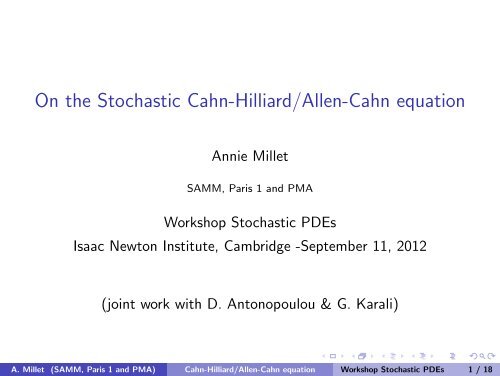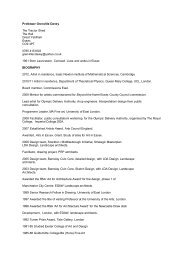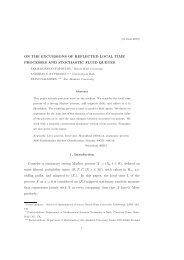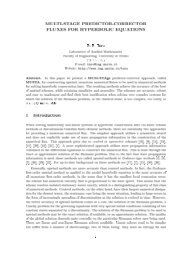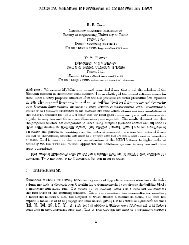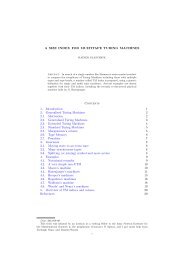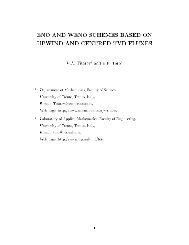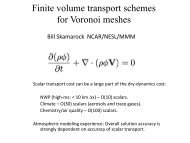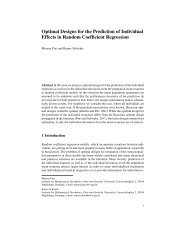On the Stochastic Cahn-Hilliard/Allen-Cahn equation - Isaac Newton ...
On the Stochastic Cahn-Hilliard/Allen-Cahn equation - Isaac Newton ...
On the Stochastic Cahn-Hilliard/Allen-Cahn equation - Isaac Newton ...
Create successful ePaper yourself
Turn your PDF publications into a flip-book with our unique Google optimized e-Paper software.
<strong>On</strong> <strong>the</strong> <strong>Stochastic</strong> <strong>Cahn</strong>-<strong>Hilliard</strong>/<strong>Allen</strong>-<strong>Cahn</strong> <strong>equation</strong><br />
Annie Millet<br />
SAMM, Paris 1 and PMA<br />
Workshop <strong>Stochastic</strong> PDEs<br />
<strong>Isaac</strong> <strong>Newton</strong> Institute, Cambridge -September 11, 2012<br />
(joint work with D. Antonopoulou & G. Karali)<br />
A. Millet (SAMM, Paris 1 and PMA) <strong>Cahn</strong>-<strong>Hilliard</strong>/<strong>Allen</strong>-<strong>Cahn</strong> <strong>equation</strong> Workshop <strong>Stochastic</strong> PDEs 1 / 18
Outline<br />
1 Introduction<br />
2 Well-posedeness result in L q (O)<br />
3 Regularity of <strong>the</strong> solution<br />
4 Regularity of <strong>the</strong> distribution<br />
A. Millet (SAMM, Paris 1 and PMA) <strong>Cahn</strong>-<strong>Hilliard</strong>/<strong>Allen</strong>-<strong>Cahn</strong> <strong>equation</strong> Workshop <strong>Stochastic</strong> PDEs 2 / 18
Outline<br />
1 Introduction<br />
2 Well-posedeness result in L q (O)<br />
3 Regularity of <strong>the</strong> solution<br />
4 Regularity of <strong>the</strong> distribution<br />
A. Millet (SAMM, Paris 1 and PMA) <strong>Cahn</strong>-<strong>Hilliard</strong>/<strong>Allen</strong>-<strong>Cahn</strong> <strong>equation</strong> Workshop <strong>Stochastic</strong> PDEs 2 / 18
Outline<br />
1 Introduction<br />
2 Well-posedeness result in L q (O)<br />
3 Regularity of <strong>the</strong> solution<br />
4 Regularity of <strong>the</strong> distribution<br />
A. Millet (SAMM, Paris 1 and PMA) <strong>Cahn</strong>-<strong>Hilliard</strong>/<strong>Allen</strong>-<strong>Cahn</strong> <strong>equation</strong> Workshop <strong>Stochastic</strong> PDEs 2 / 18
Outline<br />
1 Introduction<br />
2 Well-posedeness result in L q (O)<br />
3 Regularity of <strong>the</strong> solution<br />
4 Regularity of <strong>the</strong> distribution<br />
A. Millet (SAMM, Paris 1 and PMA) <strong>Cahn</strong>-<strong>Hilliard</strong>/<strong>Allen</strong>-<strong>Cahn</strong> <strong>equation</strong> Workshop <strong>Stochastic</strong> PDEs 2 / 18
The stochastic model<br />
O is a rectangular domain in Rd , d = 1, 2, 3,<br />
or O is a bounded piecewise smooth convex or a smooth Lipschitz domain<br />
(with ”smooth” boundary)<br />
ν outward normal, ϱ > 0 is a ”diffusion constant”,<br />
f is a polynomial of degree 3 with a positive leading coefficient, such as<br />
f = F ′ where F (u) = (1 − u2 ) 2 is a double equal-well potential,<br />
W is space-time white noise<br />
� � � �<br />
ut = −ϱ∆ ∆u − f (u) + ∆u − f (u) + σ(u) ˙W in O × [0, T ],<br />
u(x, 0) = u0(x) in O,<br />
∂u<br />
∂ν<br />
= ∂∆u<br />
∂ν<br />
= 0 on ∂O × [0, T ],<br />
Deterministic forcing for a physical model studied by <strong>Cahn</strong>, Ertl, Halperin,<br />
<strong>Hilliard</strong>, Hohenberg, Karali, Katsoutalis, Imbihl, Novick-Cohen, Segel,<br />
Vlachos, ...<br />
A. Millet (SAMM, Paris 1 and PMA) <strong>Cahn</strong>-<strong>Hilliard</strong>/<strong>Allen</strong>-<strong>Cahn</strong> <strong>equation</strong> Workshop <strong>Stochastic</strong> PDEs 3 / 18
Physical interpretation<br />
In <strong>the</strong> <strong>Cahn</strong>-<strong>Hilliard</strong> <strong>equation</strong> u scaled concentration of an alloy;<br />
−∆u + f (u) models <strong>the</strong> chemical potential, Neumann BC:<br />
conservation of mass and insulation from outside, F free energy.<br />
The general <strong>equation</strong> models surface diffusion/adsorption vapor<br />
deposition, catalysis, surface processes involving transport and<br />
chemistry of precursors in a gas phase (unconsumed reactants and<br />
radical absorb so that surface diffusion, or reaction and desorption<br />
back to <strong>the</strong> gas)<br />
Statistical mechanics Arrhenius adsorption/desorption dynamics,<br />
Metropolis surface diffusion and simple unimolecular reaction;<br />
Simplified mean field ma<strong>the</strong>matical model : Combination of <strong>the</strong><br />
<strong>Cahn</strong>-Hiliard eq. (surface diffusion, particle/particle interaction) and<br />
<strong>Allen</strong>-<strong>Cahn</strong> eq. (adsorption to and desorption to surface): mean field<br />
PDE (0 < ɛ
Physical interpretation<br />
In <strong>the</strong> <strong>Cahn</strong>-<strong>Hilliard</strong> <strong>equation</strong> u scaled concentration of an alloy;<br />
−∆u + f (u) models <strong>the</strong> chemical potential, Neumann BC:<br />
conservation of mass and insulation from outside, F free energy.<br />
The general <strong>equation</strong> models surface diffusion/adsorption vapor<br />
deposition, catalysis, surface processes involving transport and<br />
chemistry of precursors in a gas phase (unconsumed reactants and<br />
radical absorb so that surface diffusion, or reaction and desorption<br />
back to <strong>the</strong> gas)<br />
Statistical mechanics Arrhenius adsorption/desorption dynamics,<br />
Metropolis surface diffusion and simple unimolecular reaction;<br />
Simplified mean field ma<strong>the</strong>matical model : Combination of <strong>the</strong><br />
<strong>Cahn</strong>-Hiliard eq. (surface diffusion, particle/particle interaction) and<br />
<strong>Allen</strong>-<strong>Cahn</strong> eq. (adsorption to and desorption to surface): mean field<br />
PDE (0 < ɛ
Physical interpretation<br />
In <strong>the</strong> <strong>Cahn</strong>-<strong>Hilliard</strong> <strong>equation</strong> u scaled concentration of an alloy;<br />
−∆u + f (u) models <strong>the</strong> chemical potential, Neumann BC:<br />
conservation of mass and insulation from outside, F free energy.<br />
The general <strong>equation</strong> models surface diffusion/adsorption vapor<br />
deposition, catalysis, surface processes involving transport and<br />
chemistry of precursors in a gas phase (unconsumed reactants and<br />
radical absorb so that surface diffusion, or reaction and desorption<br />
back to <strong>the</strong> gas)<br />
Statistical mechanics Arrhenius adsorption/desorption dynamics,<br />
Metropolis surface diffusion and simple unimolecular reaction;<br />
Simplified mean field ma<strong>the</strong>matical model : Combination of <strong>the</strong><br />
<strong>Cahn</strong>-Hiliard eq. (surface diffusion, particle/particle interaction) and<br />
<strong>Allen</strong>-<strong>Cahn</strong> eq. (adsorption to and desorption to surface): mean field<br />
PDE (0 < ɛ
Physical interpretation<br />
In <strong>the</strong> <strong>Cahn</strong>-<strong>Hilliard</strong> <strong>equation</strong> u scaled concentration of an alloy;<br />
−∆u + f (u) models <strong>the</strong> chemical potential, Neumann BC:<br />
conservation of mass and insulation from outside, F free energy.<br />
The general <strong>equation</strong> models surface diffusion/adsorption vapor<br />
deposition, catalysis, surface processes involving transport and<br />
chemistry of precursors in a gas phase (unconsumed reactants and<br />
radical absorb so that surface diffusion, or reaction and desorption<br />
back to <strong>the</strong> gas)<br />
Statistical mechanics Arrhenius adsorption/desorption dynamics,<br />
Metropolis surface diffusion and simple unimolecular reaction;<br />
Simplified mean field ma<strong>the</strong>matical model : Combination of <strong>the</strong><br />
<strong>Cahn</strong>-Hiliard eq. (surface diffusion, particle/particle interaction) and<br />
<strong>Allen</strong>-<strong>Cahn</strong> eq. (adsorption to and desorption to surface): mean field<br />
PDE (0 < ɛ
Previous results with stochastic forcing<br />
<strong>Stochastic</strong> <strong>Cahn</strong>-<strong>Hilliard</strong> <strong>equation</strong> on a rectangle (only <strong>the</strong> bi-Laplacian):<br />
f = F ′ where F is some ”double well potential” polynomial<br />
∂tu(x, t) = −∆[∆u(x, t) − f (u(x, t))] + σ(u(x, t)) ˙W (x, t)<br />
dimension 1 with additive space-time white noise distribution<br />
solutions (dimension d ≥ 2, L 2 (O) solution for addive colored noise)<br />
Da Prato, Debussche, 1996)<br />
dimension 1 to 3: Cardon-Weber with multiplicative space time white<br />
noise on a rectangle 2001 (dimension 4 and 5, Cardon-Weber & M.<br />
with colored noise, 2004); <strong>the</strong> diffusion coefficient σ is Lipschitz and<br />
bounded.<br />
O = (0, 1) and f (u) = θ/2 ln( 1+u<br />
1−u ) − θcu with θ < θc with additive<br />
noise and reflection measures Debussche & Goudenège (2011)<br />
A. Millet (SAMM, Paris 1 and PMA) <strong>Cahn</strong>-<strong>Hilliard</strong>/<strong>Allen</strong>-<strong>Cahn</strong> <strong>equation</strong> Workshop <strong>Stochastic</strong> PDEs 5 / 18
Previous results with stochastic forcing<br />
<strong>Stochastic</strong> <strong>Cahn</strong>-<strong>Hilliard</strong> <strong>equation</strong> on a rectangle (only <strong>the</strong> bi-Laplacian):<br />
f = F ′ where F is some ”double well potential” polynomial<br />
∂tu(x, t) = −∆[∆u(x, t) − f (u(x, t))] + σ(u(x, t)) ˙W (x, t)<br />
dimension 1 with additive space-time white noise distribution<br />
solutions (dimension d ≥ 2, L 2 (O) solution for addive colored noise)<br />
Da Prato, Debussche, 1996)<br />
dimension 1 to 3: Cardon-Weber with multiplicative space time white<br />
noise on a rectangle 2001 (dimension 4 and 5, Cardon-Weber & M.<br />
with colored noise, 2004); <strong>the</strong> diffusion coefficient σ is Lipschitz and<br />
bounded.<br />
O = (0, 1) and f (u) = θ/2 ln( 1+u<br />
1−u ) − θcu with θ < θc with additive<br />
noise and reflection measures Debussche & Goudenège (2011)<br />
A. Millet (SAMM, Paris 1 and PMA) <strong>Cahn</strong>-<strong>Hilliard</strong>/<strong>Allen</strong>-<strong>Cahn</strong> <strong>equation</strong> Workshop <strong>Stochastic</strong> PDEs 5 / 18
Previous results with stochastic forcing<br />
<strong>Stochastic</strong> <strong>Cahn</strong>-<strong>Hilliard</strong> <strong>equation</strong> on a rectangle (only <strong>the</strong> bi-Laplacian):<br />
f = F ′ where F is some ”double well potential” polynomial<br />
∂tu(x, t) = −∆[∆u(x, t) − f (u(x, t))] + σ(u(x, t)) ˙W (x, t)<br />
dimension 1 with additive space-time white noise distribution<br />
solutions (dimension d ≥ 2, L 2 (O) solution for addive colored noise)<br />
Da Prato, Debussche, 1996)<br />
dimension 1 to 3: Cardon-Weber with multiplicative space time white<br />
noise on a rectangle 2001 (dimension 4 and 5, Cardon-Weber & M.<br />
with colored noise, 2004); <strong>the</strong> diffusion coefficient σ is Lipschitz and<br />
bounded.<br />
O = (0, 1) and f (u) = θ/2 ln( 1+u<br />
1−u ) − θcu with θ < θc with additive<br />
noise and reflection measures Debussche & Goudenège (2011)<br />
A. Millet (SAMM, Paris 1 and PMA) <strong>Cahn</strong>-<strong>Hilliard</strong>/<strong>Allen</strong>-<strong>Cahn</strong> <strong>equation</strong> Workshop <strong>Stochastic</strong> PDEs 5 / 18
Weak formulation<br />
O ”regular” bounded domain in Rd , d = 1, 2, 3<br />
space-time white noise written as W (dx, ds) � for a one-dimensional �<br />
(d + 1)-parameter Wiener process W :=<br />
�<br />
�<br />
W (x, t) : t ∈ [0, T ], x ∈ O<br />
and Ft = σ W (x, s) : s ≤ t, x ∈ O<br />
ϱ = 1, f polynomial of degree 3 with positive leading coefficient<br />
� �<br />
�<br />
u(x, t) − u0(x) φ(x) dx =<br />
O<br />
� t � �<br />
− ∆<br />
0 O<br />
2 �<br />
φ(x)u(x, s) + ∆φ(x)[f (u(x, s)) + u(x, s)] dxds<br />
� t �<br />
� t �<br />
− φ(x)f (u(x, s)dxds + φ(x)σ(u(x, s)) W (dx, ds)<br />
0 O<br />
0 O<br />
for φ ∈ C 4 (O) with ∂φ<br />
∂ν<br />
= ∂∆φ<br />
∂ν<br />
= 0 on ∂O.<br />
A. Millet (SAMM, Paris 1 and PMA) <strong>Cahn</strong>-<strong>Hilliard</strong>/<strong>Allen</strong>-<strong>Cahn</strong> <strong>equation</strong> Workshop <strong>Stochastic</strong> PDEs 6 / 18
Global existence<br />
Theorem<br />
Let u0 ∈ L q (O) with q ∈ [6, +∞) and σ : R → R be globally Lipschitz<br />
with <strong>the</strong> following sublinear growth:<br />
There exists constants α ∈ [0, 1/9) and C > 0 such that for all u ∈ R,<br />
|σ(u)| ≤ C(1 + |u| α )<br />
Then for every T > 0, <strong>the</strong> stochastic <strong>Cahn</strong>-<strong>Hilliard</strong>/<strong>Allen</strong>-<strong>Cahn</strong> <strong>equation</strong><br />
has a unique weak solution (strong in <strong>the</strong> probabilistic sense)<br />
u(x, t) : (x, t) ∈ O × [0, T ]. Fur<strong>the</strong>rmore a.s. u ∈ L ∞� 0, T ; L q (O) �<br />
Remark: The above result also holds true for <strong>the</strong> solution to <strong>the</strong> stochastic<br />
<strong>Cahn</strong>-<strong>Hilliard</strong> <strong>equation</strong>. This improves previous results of Cardon-Weber.<br />
A. Millet (SAMM, Paris 1 and PMA) <strong>Cahn</strong>-<strong>Hilliard</strong>/<strong>Allen</strong>-<strong>Cahn</strong> <strong>equation</strong> Workshop <strong>Stochastic</strong> PDEs 7 / 18
Sketch of <strong>the</strong> proof: Integral representation<br />
A = −∆ on D(A) :=<br />
�<br />
u ∈ H 2 (O) : ∂u<br />
∂ν<br />
�<br />
= 0 with ∂O<br />
S(t) semi-group generated by L = −∆2 + ∆<br />
Green function G fundamental solution to δtu − Lu = 0 with B.C.<br />
Represent <strong>the</strong> weak solution of <strong>the</strong> stochastic <strong>Cahn</strong>-<strong>Hilliard</strong>/<strong>Allen</strong>-<strong>Cahn</strong><br />
<strong>equation</strong> in an integral form for any x ∈ O and t ∈ [0, T ]:<br />
�<br />
u(x, t) = u0(y)G(x, y, t) dy<br />
O<br />
� t �<br />
� �<br />
+ ∆G(x, y, t − s) − G(x, y, t − s) f (u(y, s)) dyds<br />
0 O<br />
� t �<br />
+ G(x, y, t − s)σ(u(y, s)) W (dy, ds)<br />
0<br />
O<br />
A. Millet (SAMM, Paris 1 and PMA) <strong>Cahn</strong>-<strong>Hilliard</strong>/<strong>Allen</strong>-<strong>Cahn</strong> <strong>equation</strong> Workshop <strong>Stochastic</strong> PDEs 8 / 18
Sketch of proof (continued)<br />
Then <strong>the</strong>re exist positive constants C, c such that<br />
d<br />
−<br />
|G(x, y, t)| ≤ Ct 4 exp � − c |x − y| 4<br />
3 t<br />
d+2<br />
−<br />
|∆G(x, y, t)| ≤ Ct 4 exp � − c |x − y| 4<br />
3 t<br />
d+4<br />
−<br />
|∂tG(x, y, t)| ≤ Ct 4 exp � − c |x − y| 4<br />
3 t<br />
Fur<strong>the</strong>rmore, given x, z ∈ O and t ≥ s ≥ 0,<br />
�<br />
� t<br />
0<br />
� s<br />
0<br />
�<br />
1 � − 3 ,<br />
− 1<br />
3<br />
� ,<br />
1 � − 3 .<br />
|G(x, y, t − r) − G(z, y, t − r)|<br />
O<br />
2 dydr ≤ C|x − z| γ<br />
|G(x, y, t − r) − G(x, y, s − r)|<br />
O<br />
2 dydr ≤ C|t − s| γ′<br />
� t �<br />
|G(x, y, t − r)|<br />
s O<br />
2 dr ≤ C|t − s| γ′<br />
for γ < 4 − d, γ ≤ 2 and γ ′ < 1 − d<br />
4 .<br />
A. Millet (SAMM, Paris 1 and PMA) <strong>Cahn</strong>-<strong>Hilliard</strong>/<strong>Allen</strong>-<strong>Cahn</strong> <strong>equation</strong> Workshop <strong>Stochastic</strong> PDEs 9 / 18
Sketch of proof (continued)<br />
Study <strong>the</strong> truncated <strong>equation</strong>: cut-off function χn of class C1 such that<br />
|χn| ≤ 1, |χ ′ n| ≤ 2, χn(x) = 1 if x ≤ n and χn(x) = 0 if x ≥ n + 1.<br />
�<br />
un(x, t) = u0(y)G(x, y, t) dy<br />
O<br />
� t �<br />
� �<br />
+ ∆G(x, y, t − s) − G(x, y, t − s) χn(�un(·, s)�q) f (un(y, s)) dyds<br />
0 O<br />
� t �<br />
+ G(x, y, t − s) χn(�un(·, s)�q) σ(un(y, s)) W (dy, ds)<br />
0<br />
O<br />
A. Millet (SAMM, Paris 1 and PMA) <strong>Cahn</strong>-<strong>Hilliard</strong>/<strong>Allen</strong>-<strong>Cahn</strong> <strong>equation</strong> Workshop <strong>Stochastic</strong> PDEs 10 / 18
Sketch of proof (continued)<br />
The truncated SPDE has a unique solution on every time interval [0, T ].<br />
For ”small” T and β ∈ [q, ∞), fixed point <strong>the</strong>orem in <strong>the</strong> space<br />
�<br />
HT = u adapted : �u� β<br />
�<br />
= sup E �u(., t)� HT<br />
t≤T<br />
β � �<br />
q < ∞<br />
Extend <strong>the</strong> unique solution on any time interval<br />
L(un)(x, t) =<br />
� t<br />
0<br />
�<br />
O<br />
G(x, y, t − s)κn(�un(y, s)�q)σ(un(y, s))W (dy, ds)<br />
Then for any p ∈ [1, ∞):<br />
�<br />
E sup |L(un)(x, t)|<br />
t,x<br />
2p�<br />
≤ Cp(T )(1 + n 2αp )<br />
and vn = un − L(un).<br />
A. Millet (SAMM, Paris 1 and PMA) <strong>Cahn</strong>-<strong>Hilliard</strong>/<strong>Allen</strong>-<strong>Cahn</strong> <strong>equation</strong> Workshop <strong>Stochastic</strong> PDEs 11 / 18
Sketch of proof (continued)<br />
Using vn = un − L(un) which solves<br />
∂tvn + (−∆ + 1)(−∆)vn + (−∆ + 1)χn(�vn + Lun�q)f (vn + L(un)) = 0<br />
• Apply (−∆ + Id) −1 yields <strong>the</strong> existence of constants C1 and C2 such that<br />
� t<br />
0<br />
χn(�un(., s)�q)�un(., s)� 4 4ds ≤C1(1.B(u0))<br />
+ C2<br />
� t<br />
0<br />
χn(�un(., s)�q)�Lun(., s)� 4 4ds<br />
• energie estimates on <strong>the</strong> Galerkin approximation,<br />
|f (x + y) − f (x)| ≤ C|y|(1 + x 2 + y 2 ) and Hölder’s inequality yield<br />
��<br />
E<br />
� T<br />
�un(·, t)� a �β� �<br />
q dt ≤ C(T )<br />
0<br />
�u0� aβ<br />
2 +1+n3aαβ +(1+n aαβ )B(u0) aβ<br />
2<br />
for a ∈ [q, ∞) and β ∈ [1, ∞), where for some ONB (ei, i ≥ 0) of L2 (O)<br />
B(u0) := 1<br />
� ∞�<br />
�<br />
�<br />
1<br />
− �<br />
� [λi + 1] 2 (u0, ei) L2 (O)ei �<br />
2<br />
2<br />
2 .<br />
i=0<br />
A. Millet (SAMM, Paris 1 and PMA) <strong>Cahn</strong>-<strong>Hilliard</strong>/<strong>Allen</strong>-<strong>Cahn</strong> <strong>equation</strong> Workshop <strong>Stochastic</strong> PDEs 12 / 18<br />
�
Sketch of proof (continued)<br />
Let Tn = inf{t > 0 : �un(., t)�q ≥ n} ∧ T <strong>the</strong> above bounds yield that<br />
lim n P(Tn < T ) ≤ C(T )n −2β(1−9α)<br />
if <strong>the</strong> sublinear growth of <strong>the</strong> ”diffusion” coefficient σ is such that<br />
|σ(u) ≤ C(1 + |u| α ) with α ∈ [0, 1<br />
9 )<br />
Borel Cantelli’s lemma yields a.s. <strong>the</strong> existence of a global solution.<br />
A. Millet (SAMM, Paris 1 and PMA) <strong>Cahn</strong>-<strong>Hilliard</strong>/<strong>Allen</strong>-<strong>Cahn</strong> <strong>equation</strong> Workshop <strong>Stochastic</strong> PDEs 13 / 18
Hölder regulatity<br />
Theorem<br />
Suppose that O = (0, π) d , d = 1, 2, 3<br />
<strong>the</strong>re exists constants α ∈ � 0, 1<br />
�<br />
36 and C > 0 such that for all u ∈ R,<br />
|σ(u)| ≤ C(1 + |u| α )<br />
(i) If u0 is continuous, <strong>the</strong>n <strong>the</strong> solution u has almost surely continuous<br />
trajectories.<br />
(ii) If u0 is γ-Hölder continuous for 0 < γ < 1, <strong>the</strong>n <strong>the</strong> trajectories of <strong>the</strong><br />
solution u are almost surely:<br />
β1 Hölder-continuous in space with β1 ≤ γ and β1 < (2 − d<br />
2 )<br />
β2 Hölder-continuous in time, with β2 ≤ γ<br />
4 and β2 < 1 d<br />
4 (2 − 2 ).<br />
Remark: Theorem true for <strong>the</strong> stochastic <strong>Cahn</strong>-<strong>Hilliard</strong> <strong>equation</strong><br />
(improves Cardon-Weber’s result)<br />
A. Millet (SAMM, Paris 1 and PMA) <strong>Cahn</strong>-<strong>Hilliard</strong>/<strong>Allen</strong>-<strong>Cahn</strong> <strong>equation</strong> Workshop <strong>Stochastic</strong> PDEs 14 / 18
Idea of <strong>the</strong> proof<br />
(i) Use <strong>the</strong> explicit form of <strong>the</strong> Green function for <strong>the</strong> integral involving<br />
<strong>the</strong> initial condition (requires that O is a rectangle)<br />
(ii) Use <strong>the</strong> Kolmogorov criterion for <strong>the</strong> stochastic integral, <strong>the</strong> identity<br />
u = un on {Tn = T } and <strong>the</strong> above upper estimates of un and P(Tn < T )<br />
(iii) Use upper bounds of <strong>the</strong> space and time partial derivatives of <strong>the</strong><br />
Green function.<br />
(iv) For <strong>the</strong> deterministic integrals use <strong>the</strong> factorization method.<br />
Remark : Unlike S. Cerrai 2003 (and M. Kuntze & J. Van Neerven 2012)<br />
we do not see how to use subdifferentials and have linear growth of σ,<br />
even for ”regular” initial conditions.<br />
This is due to <strong>the</strong> Laplace operator in front of <strong>the</strong> non-linearity<br />
A. Millet (SAMM, Paris 1 and PMA) <strong>Cahn</strong>-<strong>Hilliard</strong>/<strong>Allen</strong>-<strong>Cahn</strong> <strong>equation</strong> Workshop <strong>Stochastic</strong> PDEs 15 / 18
Regularity of <strong>the</strong> distribution<br />
Theorem<br />
Suppose that O = (0, π) d , d = 1, 2, 3, u0 is continuous,<br />
|σ(u)| ≤ C(1 + |u| α ) for α ∈ � 0, 1<br />
�<br />
36 and σ does not vanish.<br />
Then for every t > 0 and x ∈ D, <strong>the</strong> distribution of u(x, t) has a density.<br />
Idea of <strong>the</strong> proof:<br />
(i) use <strong>the</strong> continuity of u to have P(Ωn) → 1 where<br />
Ωn = {ω : sup<br />
t<br />
sup |u(x, t, ω)| ≤ n}<br />
x<br />
(ii) for χn previous cut-off function, let ũn = u on Ωn satisfy<br />
�<br />
ũn(x, t) = u0(y)G(x, y, t) dy<br />
O<br />
� t �<br />
� �<br />
+ ∆G(x, y, t − s) − G(x, y, t − s) χn(|ũn(y, s)|)f (ũn(y, s)) dyds<br />
0 O<br />
� t �<br />
+ G(x, y, t − s)σ(ũn(y, s)) W (dy, ds)<br />
0 O<br />
A. Millet (SAMM, Paris 1 and PMA) <strong>Cahn</strong>-<strong>Hilliard</strong>/<strong>Allen</strong>-<strong>Cahn</strong> <strong>equation</strong> Workshop <strong>Stochastic</strong> PDEs 16 / 18
Regularity of <strong>the</strong> distribution (continued)<br />
Prove that for every (t, x), ũn(x, t) belongs to D1,2 � t �<br />
and<br />
sup E<br />
t,x<br />
|Dz,r ũn(x, t)| 2 dzdr = Cn < ∞<br />
0<br />
O<br />
� t �<br />
sup sup E<br />
s∈[t−ɛ,t] y t−ɛ<br />
|Dz,r ũn(y, s)|<br />
O<br />
2 dzdr ≤ Cnɛ 2−d/2<br />
(iii) Suppose that σ = 1; <strong>the</strong>n Dz,r ũn(x, t) = G(t − r, x, z) + Qz,r (x, t)<br />
and for t > 0 and 0 < ɛ < t:<br />
� t �<br />
|Dz,r ũn(x, t)| 2 dzdr ≥ 1<br />
2 I1(t, x, ɛ) − I2(x, t, ɛ)<br />
0<br />
O<br />
for I1(x, t, ɛ) = � t<br />
t−ɛ<br />
�<br />
O G 2 (t − r, x, z)dzdr≥ Cɛ 1−d/4<br />
I2(x, t, ɛ) =<br />
� t<br />
t−ɛ<br />
�<br />
O<br />
Qz,r (x, t) 2 dzdr<br />
A. Millet (SAMM, Paris 1 and PMA) <strong>Cahn</strong>-<strong>Hilliard</strong>/<strong>Allen</strong>-<strong>Cahn</strong> <strong>equation</strong> Workshop <strong>Stochastic</strong> PDEs 17 / 18
Regularity of <strong>the</strong> distribution (continued)<br />
For σ = 1, <strong>the</strong> ”main” term is ɛ1−d/4 since 2 − d/2 > 1 − d/4.<br />
Thus <strong>the</strong> truncated sequence ũn is such that for t > 0,<br />
� t �<br />
|Dz,r ũn(x, t)| 2 dzdr > 0 a.s.<br />
(iv) For σ which does not vanish, write<br />
0<br />
O<br />
Dz,r ũn(x, t) = σ(ũn(x, t))vn(z, r)<br />
where vn(z, r) behaves as <strong>the</strong> previous Malliavin derivative (when σ = 1)<br />
for t > 0,<br />
� t<br />
0<br />
�<br />
O<br />
|Dz,r ũn(x, t)| 2 dzdr > 0 a.s.<br />
ũn(x, t) has a density (Bouleau-Hirsch criterion)<br />
u = ũn on Ωn and P(Ωn) → 1 implies that u(x, t) has a density.<br />
A. Millet (SAMM, Paris 1 and PMA) <strong>Cahn</strong>-<strong>Hilliard</strong>/<strong>Allen</strong>-<strong>Cahn</strong> <strong>equation</strong> Workshop <strong>Stochastic</strong> PDEs 18 / 18


